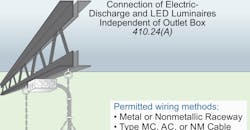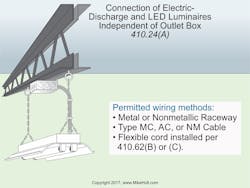Stumped by the Code? Connection of Electric-Discharge and LED luminaires Supported Independently of the Outlet Box
All questions and answers are based on the 2017 NEC.
Q. What does the Code allow for the connection of electric-discharge and LED luminaires when they are supported independently of the outlet box?
A. Electric-discharge and LED luminaires supported independently of the outlet box must be connected to the branch circuit with a raceway, or with Types MC, AC, NM cable, or flexible cord installed per Sec. 410.62(B) or (C) [410.24(A)] (see Figure).
Electric-discharge luminaires can be cord-connected if the luminaires are provided with internal adjustments to position the lamp [Sec. 410.62(B)].
Electric-discharge luminaires can be cord-connected if the flexible cord is visible for its entire length, is plugged into a receptacle, and the installation complies with Sec. 410.62(C).
Q. What are the requirements for installing surface-mounting electric-discharge and LED luminaires over a concealed outlet box?
A. When an electric-discharge luminaire or LED luminaire is surface-mounted over a concealed outlet box and not supported by the outlet box, the luminaire must be provided with suitable openings that permit access to the branch-circuit wiring within the outlet box [Sec. 410.16(B)].
Q. What are the Code requirements when using poles as luminaire supports?
A. Luminaires and lampholders must be securely supported [Sec. 410.30(A)]. Poles are permitted to be used to support luminaires and as a raceway to enclose supply conductors where the following conditions are met [Sec. 410.30(B)].
(1) The pole must have an accessible 2 in. × 4 in. handhole with a cover suitable for use in wet locations that provides access to the supply conductors within the pole.
Exception No. 1: The handhole isn’t required for a pole that’s 8 ft or less in height if the supply conductors for the luminaire are accessible by removing the luminaire.
Exception No. 2: The handhole can be omitted on poles that are 20 ft or less in height, if the pole is provided with a hinged base.
(2) When the supply raceway or cable doesn’t enter the pole, a threaded fitting or nipple must be welded, brazed, or attached to the pole opposite the handhole opening for the supply conductors.
(3) A metal pole must have an equipment grounding terminal accessible from the handhole.
Exception: A grounding terminal isn’t required in a pole that’s 8 ft or less in height above grade if the splices are accessible by removing the luminaire.
(5) Metal poles used for the support of luminaires must be connected to an equipment grounding conductor of a type recognized in Sec. 250.118 [250.4(A)(5)].
DANGER: Because the contact resistance of an electrode to the earth is so high, very little fault current returns to the power supply if the earth is the only fault current return path. Result — the circuit overcurrent protection device won’t open and clear the ground fault, and the metal pole will become and remain energized by the circuit voltage.
(6) Conductors in vertical metal poles must be supported when the vertical rise exceeds 100 ft [Table 300.19(A)].
When provided by the manufacturer of roadway lighting poles, so-called J-hooks must be used to support conductors, as they’re part of the listing instructions [Sec. 110.3(B)].
With security being a high priority, many owners want to install security cameras on existing parking lot poles. However, Sec. 820.133(A)(1)(b) prohibits the mixing of power and communications conductors in the same raceway.
About the Author

Mike Holt
Mike Holt is the owner of Mike Holt Enterprises (www.MikeHolt.com), one of the largest electrical publishers in the United States. He earned a master's degree in the Business Administration Program (MBA) from the University of Miami. He earned his reputation as a National Electrical Code (NEC) expert by working his way up through the electrical trade. Formally a construction editor for two different trade publications, Mike started his career as an apprentice electrician and eventually became a master electrician, an electrical inspector, a contractor, and an educator. Mike has taught more than 1,000 classes on 30 different electrical-related subjects — ranging from alarm installations to exam preparation and voltage drop calculations. He continues to produce seminars, videos, books, and online training for the trade as well as contribute monthly Code content to EC&M magazine.

